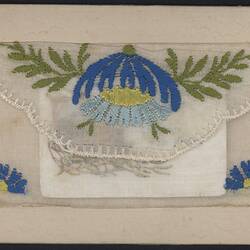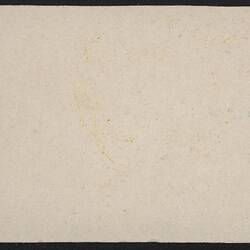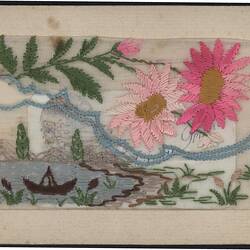Summary
Embroidered postcard with muslin flap with smaller rectangular card inside. Sent by 'Andy' to his mother and 'Jess', presumably whilst he was serving on the Western Front during World War I.
The exact identity of the people named on the postcard remains unknown; however, another postcard in the same auction lot is from a 'Thomas' to 'Jessie' (HT 30622) and contains a smaller card that bears the inscription: 'To Mrs A Fox / From C Glendenning / With all good wishes.' Although the exact relationship between the smaller card and Thomas and Jessie is unknown, the 'A. Fox' may refer to Private Andrew Fox who served with the A.I.F. as part of the 13th Battalion, 21st Reinforcement and is a likely candidate for 'Andy' as well. Also in the same lot is a postcard from 'Tom' to his cousin 'Molly' (HT 30630), possibly another reference to the Thomas who signed the card to Jessie. The C. Glendenning mentioned on the card included with the postcard to Jessie may be a reference to a Private Clarence Glendenning who served with the A.I.F. as part of the 15th Battalion, 8th Reinforcement. However, the exact identity of all persons associated with these messages remains unclear.
According to the Australian War Memorial, the popularity of embroidered postcards (first made for the Paris Exposition in 1900) peaked during World War I. Many were 'embroidered by French women in their homes and then sent to the factories for cutting and mounting on postcards'. Common themes included family, remembrance, liberty, unity and war souvenirs.
Description of Content
On upper piece of muslin - a circular pattern in two shades of both blue and green, blue two-forked lines stemming from a green circle and a yellow-green oval. Green leaves emerge from the pattern on both sides. Lower piece of muslin is largely blank with an image in each corner of yellow-green circle with three blue two-forked lines stemming from the circular centre. Patterned cardboard border (check original for more detail).
Physical Description
A cardboard postcard with two pieces of muslin with white lining attached to the top and bottom of a corrugated cardboard border. Colourful images and text sewn onto muslin. Top piece lifts up to reveal a rectangular card tucked into lower piece of muslin. The rectangular card has a printed image and statement on the front, and a blank back. Handwritten message on back of postcard. The back of the postcard displays printed text with a dividing-back.
Significance
Embroidered postcards were very popular during World War I, with common themes including family, remembrance, liberty and unity. Their popularity began to wane after the war and they are not found after c.1923, making embroidered postcards a souvenir unique to World War I.
More Information
-
Collecting Areas
-
Acquisition Information
Purchase
-
Place Named
-
Format
Postcard
-
Inscriptions
Printed in black ink along the centre dividing line on the back of the postcard: 'Fabrication Francaise' Hand-written in pencil on the back of the postcard, left hand side: 'To Mother & Jess' Hand-written in pencil on the back of the postcard, right hand side: 'Best Wishes (crossed out) from / & love from / Andy / XXX' Printed in blue ink on the front of an attached rectangular card: 'Greetings / from France'
-
Classification
-
Category
-
Discipline
-
Type of item
-
Overall Dimensions
138 mm (Width), 88 mm (Height)
-
Overall Dimensions
64 mm (Width), 44 mm (Height)
-
Keywords






